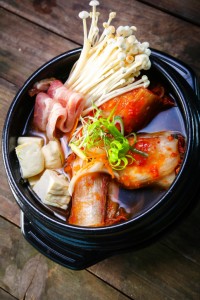
Traditional Korean meals are noted for the number of side dishes that accompany steam-cooked short-grain rice. Kimchi is one of the most iconic of Korean dishes. Consequently, it is almost always served at meals.
Korean food has evolved through centuries of social and political change. Originating from ancient agricultural and nomadic traditions in the Korean peninsula and southern Manchuria, Korean cuisine has developed through a complex interaction of the natural environment and different cultural trends. Korean food is largely based on rice, vegetables, and meats. Traditional Korean meals are noted for the number of side dishes that accompany steam-cooked short-grain rice. Kimchi is one of the most iconic of Korean dishes. Consequently, it is almost always served at meals. Commonly used ingredients in Korean dishes include sesame oil, doenjang (fermented bean paste), soy sauce, salt, garlic, ginger, pepper flakes, gochujang (fermented red chili paste) and napa cabbage.
Delicious Korean Dishes
- Kimchi: Dating to the Shilla Dynasty, approximately 2,000 years ago, kimchi is the beloved spicy sidekick at every Korean table. It’s made by salting and preserving fermented cabbage in a bed of pepper, garlic, ginger, and scallion.
- Soft Tofu Stew: Soft tofu, clams, and an egg in spicy broth. This popular stew is a classic example of unexpected flavor combinations yielding delightful sensations. The soft tofu, which breaks into fluffy chunks in the stew, holds the flavor of the clam and serves as a relief from the overall spiciness.
- Tteokbokki: This iconic red-orange street food is so popular there’s an entire town in Seoul just devoted to the steamed and sliced rice cakes, cooked with fish cakes, and scallions in a sweet and spicy sauce made of chili paste.
- Gopchang: Gopchang refers to the small intestines from pork or cattle, which, chopped into rounded sections, can be cooked into soups, stir-fried, or grilled. Grilled gopchang is yet another important aspect of Korean barbecue culture.
Healthy Eating
Among the traditions that may help keep Koreans slim and healthy is including soup at every meal, which means filling up on a relatively low-calorie but satisfying food. Studies show that soup eaters tend to eat less high-calorie fare later. Also, treating meat like a condiment rather than the main event in a meal helps keep saturated fat intake low. Obesity is still relatively rare in South Korea: just one-third of adults are overweight or obese, according to recent estimates, versus 68 percent of Americans.
Get All Your Asian Groceries at Lotte Plaza Market
Lotte Plaza Market is your one-stop shop for all of your Korean and Asian grocery needs. With more than 10 locations in Maryland and Virginia, this growing market is always expanding and opening new markets to better serve our customers. Opened since 1976, our goal has always been to provide the best customer service and groceries to our customers. For answers to all of your questions, email us at LottePlaza.com.
